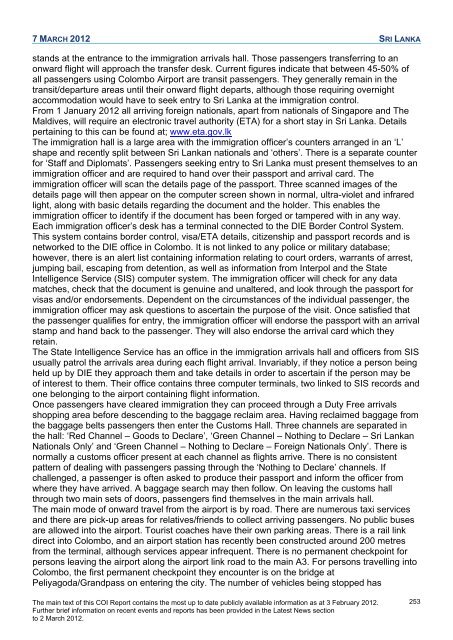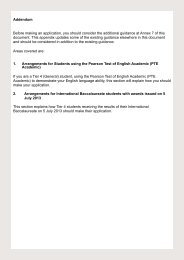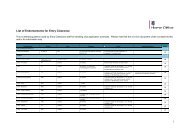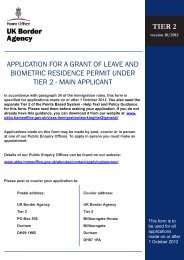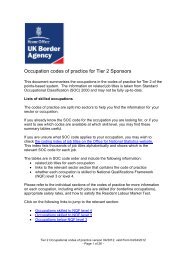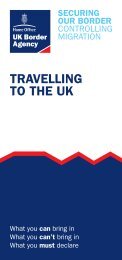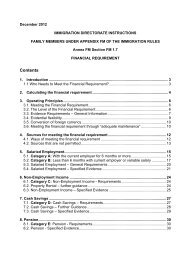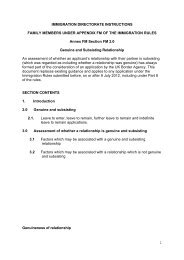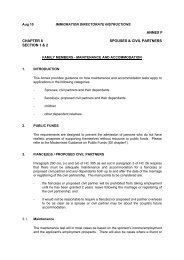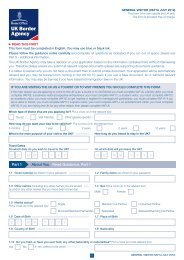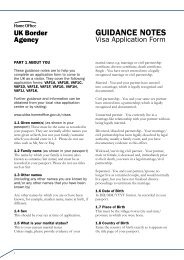COI Report March 2012 - UK Border Agency - Home Office
COI Report March 2012 - UK Border Agency - Home Office
COI Report March 2012 - UK Border Agency - Home Office
You also want an ePaper? Increase the reach of your titles
YUMPU automatically turns print PDFs into web optimized ePapers that Google loves.
7 MARCH <strong>2012</strong> SRI LANKA<br />
stands at the entrance to the immigration arrivals hall. Those passengers transferring to an<br />
onward flight will approach the transfer desk. Current figures indicate that between 45-50% of<br />
all passengers using Colombo Airport are transit passengers. They generally remain in the<br />
transit/departure areas until their onward flight departs, although those requiring overnight<br />
accommodation would have to seek entry to Sri Lanka at the immigration control.<br />
From 1 January <strong>2012</strong> all arriving foreign nationals, apart from nationals of Singapore and The<br />
Maldives, will require an electronic travel authority (ETA) for a short stay in Sri Lanka. Details<br />
pertaining to this can be found at; www.eta.gov.lk<br />
The immigration hall is a large area with the immigration officer‘s counters arranged in an ‗L‘<br />
shape and recently split between Sri Lankan nationals and ‗others‘. There is a separate counter<br />
for ‗Staff and Diplomats‘. Passengers seeking entry to Sri Lanka must present themselves to an<br />
immigration officer and are required to hand over their passport and arrival card. The<br />
immigration officer will scan the details page of the passport. Three scanned images of the<br />
details page will then appear on the computer screen shown in normal, ultra-violet and infrared<br />
light, along with basic details regarding the document and the holder. This enables the<br />
immigration officer to identify if the document has been forged or tampered with in any way.<br />
Each immigration officer‘s desk has a terminal connected to the DIE <strong>Border</strong> Control System.<br />
This system contains border control, visa/ETA details, citizenship and passport records and is<br />
networked to the DIE office in Colombo. It is not linked to any police or military database;<br />
however, there is an alert list containing information relating to court orders, warrants of arrest,<br />
jumping bail, escaping from detention, as well as information from Interpol and the State<br />
Intelligence Service (SIS) computer system. The immigration officer will check for any data<br />
matches, check that the document is genuine and unaltered, and look through the passport for<br />
visas and/or endorsements. Dependent on the circumstances of the individual passenger, the<br />
immigration officer may ask questions to ascertain the purpose of the visit. Once satisfied that<br />
the passenger qualifies for entry, the immigration officer will endorse the passport with an arrival<br />
stamp and hand back to the passenger. They will also endorse the arrival card which they<br />
retain.<br />
The State Intelligence Service has an office in the immigration arrivals hall and officers from SIS<br />
usually patrol the arrivals area during each flight arrival. Invariably, if they notice a person being<br />
held up by DIE they approach them and take details in order to ascertain if the person may be<br />
of interest to them. Their office contains three computer terminals, two linked to SIS records and<br />
one belonging to the airport containing flight information.<br />
Once passengers have cleared immigration they can proceed through a Duty Free arrivals<br />
shopping area before descending to the baggage reclaim area. Having reclaimed baggage from<br />
the baggage belts passengers then enter the Customs Hall. Three channels are separated in<br />
the hall: ‗Red Channel – Goods to Declare‘, ‗Green Channel – Nothing to Declare – Sri Lankan<br />
Nationals Only‘ and ‗Green Channel – Nothing to Declare – Foreign Nationals Only‘. There is<br />
normally a customs officer present at each channel as flights arrive. There is no consistent<br />
pattern of dealing with passengers passing through the ‗Nothing to Declare‘ channels. If<br />
challenged, a passenger is often asked to produce their passport and inform the officer from<br />
where they have arrived. A baggage search may then follow. On leaving the customs hall<br />
through two main sets of doors, passengers find themselves in the main arrivals hall.<br />
The main mode of onward travel from the airport is by road. There are numerous taxi services<br />
and there are pick-up areas for relatives/friends to collect arriving passengers. No public buses<br />
are allowed into the airport. Tourist coaches have their own parking areas. There is a rail link<br />
direct into Colombo, and an airport station has recently been constructed around 200 metres<br />
from the terminal, although services appear infrequent. There is no permanent checkpoint for<br />
persons leaving the airport along the airport link road to the main A3. For persons travelling into<br />
Colombo, the first permanent checkpoint they encounter is on the bridge at<br />
Peliyagoda/Grandpass on entering the city. The number of vehicles being stopped has<br />
The main text of this <strong>COI</strong> <strong>Report</strong> contains the most up to date publicly available information as at 3 February <strong>2012</strong>.<br />
Further brief information on recent events and reports has been provided in the Latest News section<br />
to 2 <strong>March</strong> <strong>2012</strong>.<br />
253


